#Royal Canadian Air Force CP-140 Aurora
Text
Titanic sub suffered 'catastrophic implosion,' all five aboard dead
By Joseph Ax and Steve Gorman
23 June 2023
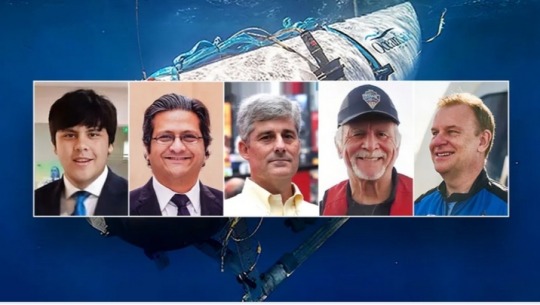
June 22 (Reuters) - The five people aboard a missing submersible died in a "catastrophic implosion," a U.S. Coast Guard official said on Thursday, bringing a grim end to the international search for the vessel that was lost during a deep-sea voyage to the wreck of the Titanic.
"These men were true explorers who shared a distinct spirit of adventure, and a deep passion for exploring and protecting the world's oceans," OceanGate Expeditions, the U.S.-based company that operated the Titan submersible, said in a statement.
"Our hearts are with these five souls and every member of their families during this tragic time."
An unmanned robot deployed from a Canadian ship discovered the wreckage of the Titan on Thursday morning about 1,600 feet (488 meters) from the bow of the century-old wreck, 2-1/2 miles (4 km) below the surface in a remote area of the North Atlantic, U.S. Coast Guard Rear Admiral John Mauger said at a press conference.
"The debris field here is consistent with a catastrophic implosion of the vehicle," Mauger said.
The five aboard included the British billionaire and explorer Hamish Harding, 58; Pakistani-born business magnate Shahzada Dawood, 48, and his 19-year-old son, Suleman, both British citizens; French oceanographer and Titanic expert Paul-Henri Nargeolet, 77, who had visited the wreck dozens of times; and Stockton Rush, the American founder and chief executive of OceanGate, who was piloting the submersible.
Rescue teams from several countries had spent days searching thousands of square miles of open seas with planes and ships for any sign of the 22-foot (6.7-meter) Titan.
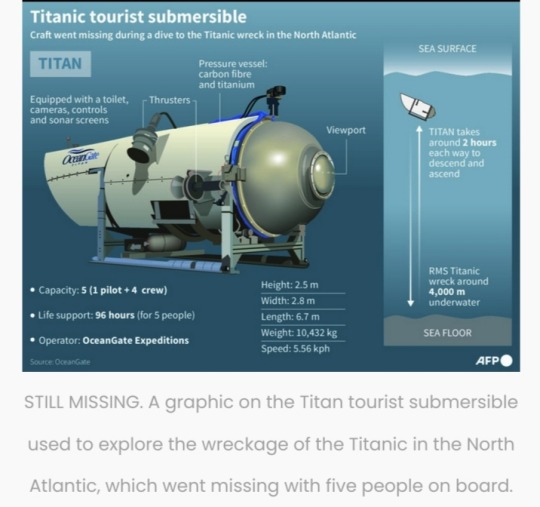
The submersible lost contact with its support ship on Sunday morning, June 18, about an hour and 45 minutes into what should have been a two-hour descent.
Mauger said it was too early to tell when the vessel's failure occurred.
The search operation had sonar buoys in the water for more than three days and had not detected any sort of loud explosive noise during the period, Mauger said.
The buoys had picked up some sounds on Tuesday and Wednesday that temporarily offered hope the people on board the Titan were alive and trying to communicate by banging on the hull.
But officials said analysis of the sound was inconclusive and that the noises might not have emanated from the Titan at all.
"There doesn't appear to be any relation between the noises and the location of the debris field on the sea floor," Mauger said on Thursday.

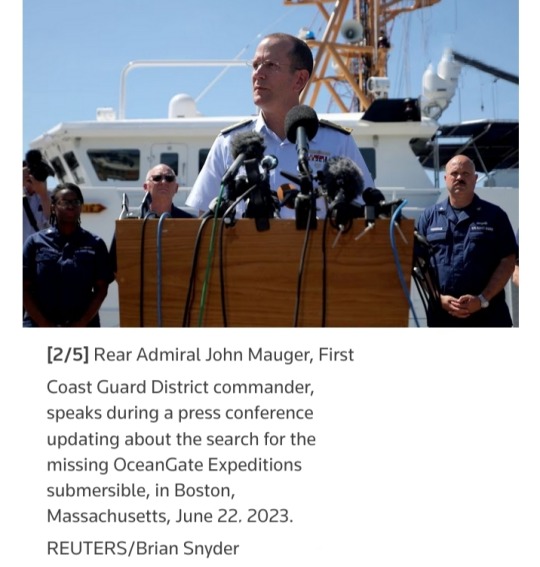
Robotic craft on the ocean floor will continue to gather evidence, Mauger said, but it is not clear whether recovering the bodies will be possible given the nature of the accident and the extreme conditions at those depths.
Five major pieces of the Titan have been found, including most of the pressure hull, officials said.
SAFETY CONCERNS
The search had grown increasingly desperate on Thursday, when the estimated 96-hour air supply was expected to run out if the Titan were still intact.
The Titanic, which sank in 1912 on its maiden voyage after hitting an iceberg, killing more than 1,500 people, lies about 900 miles (1,450 km) east of Cape Cod, Massachusetts, and 400 miles (640 km) south of St. John's, Newfoundland.
The expedition to the wreck, which OceanGate has been operating since 2021, cost $250,000 per person, according to OceanGate's website.
Questions about Titan's safety were raised in 2018 during a symposium of submersible industry experts and in a lawsuit by OceanGate's former head of marine operations, which was settled later that year.
The sweeping search covered more than 10,000 square miles of ocean - about the size of the U.S. state of Massachusetts.
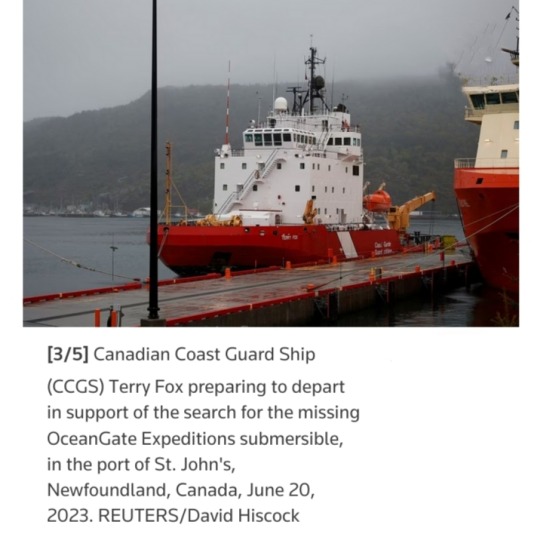
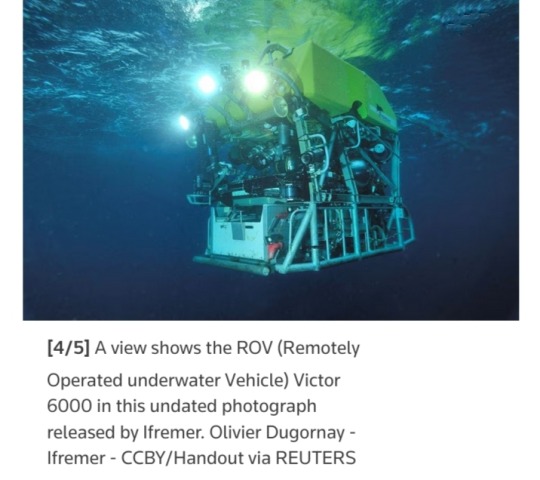

On Thursday, the deployment of two specialized deep-sea unmanned vehicles expanded the search to the ocean's depths, where immense pressure and pitch-black darkness complicated the mission.
The missing submersible and subsequent hunt captured worldwide attention, in part due to the mythology surrounding the Titanic.
The "unsinkable" British passenger liner has inspired both nonfiction and fiction accounts for a century, including the James Cameron blockbuster 1997 movie, which rekindled popular interest in the story.
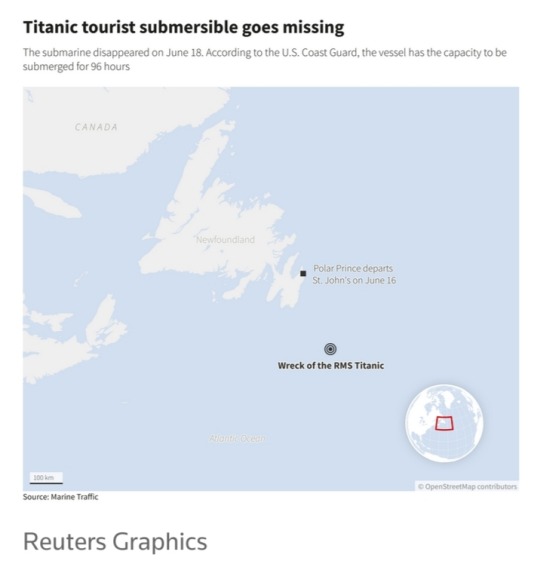
#OceanGate Expeditions#Titan submersible#catastrophic implosion#U.S. Coast Guard#U.S. Coast Guard Rear Admiral John Mauger#Titan#Titanic#Canadian Coast Guard Ship (CCGS) Terry Fox#OceanGate Expeditions submersible#Royal Canadian Air Force CP-140 Aurora#ROV#expedition#deep-sea voyage#wreckage
31 notes
·
View notes
Text

Canada moves forward to replace its Aurora fleet with P-8As jets
Fernando Valduga By Fernando Valduga 28/03/2023 - 11:00 in Military
The Canadian government sent a letter of request (LoR) to the U.S. for the purchase price of 16 P-8A Poseidon aircraft to replace the Royal Canadian Air Force (RCAF) fleet of 14 CP-140 Aurora maritime patrol aircraft.
The CP-140 Aurora fleet was originally acquired in 1980 and is scheduled to be phased out of operation in 2030.
A Requisition for Information (RFI) was released in February 2022 to obtain industry information. After commitments to industry and Canada's closest allies, the government determined that the P-8A Poseidon is the only aircraft currently available that meets all the operational requirements of the CMMA, i.e. anti-submarine war and C4ISR, the Canadian government said in a statement.
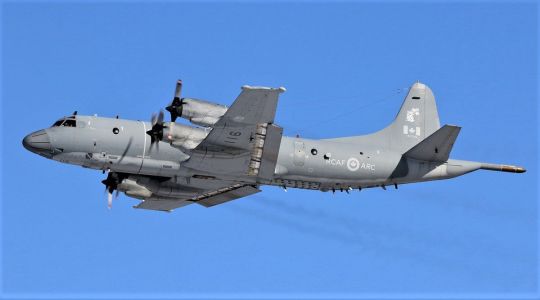
CP-140 Aurora Aircraft.
In order to explore this option in more detail, Canada recently sent a Letter of Request (LOR) through the United States government's Foreign Military Sales (FMS) program, describing Canada's requirements and requesting an offer. These requirements include up to 16 P-8A Poseidon aircraft and associated equipment and initial maintenance, as well as access to intellectual property and technical data.
The issuance of a LoR does not oblige Canada to buy the P-8A Poseidon and the project remains in Options Analysis. The final decision will be based on the capacity offered, availability, price and benefits for the Canadian industry.
Ads
REPORT THIS ANNOUNCEMENT
Tags: Military AviationBoeing P-8A PoseidonCP-140 AuroraRCAF - Royal Canadian Air Force/Canada Air Force
Fernando Valduga
Fernando Valduga
Aviation photographer and pilot since 1992, he has participated in several events and air operations, such as Cruzex, AirVenture, Dayton Airshow and FIDAE. He has works published in specialized aviation magazines in Brazil and abroad. Uses Canon equipment during his photographic work throughout the world of aviation.
Related news
MILITARY
VIDEO: Airbus A310 guides and takes control in flight of a drone
28/03/2023 - 19:00
MILITARY
VIDEO: Prototypes of the South Korean KF-21 fighter fire weapons for the first time
28/03/2023 - 14:25
MILITARY
Nordic nations move to connect their air forces in a fleet of 250 combat aircraft
28/03/2023 - 08:00
MILITARY
A400M worldwide fleet accumulates 150,000 hours
28/03/2023 - 07:58
MILITARY
USAF sends military aircraft to South Texas after NORAD detected UFO
28/03/2023 - 00:04
MILITARY
France qualifies Rafale for the F4.1 standard
27/03/2023 - 18:3
11 notes
·
View notes
Text
Boeing Awarded $3.4 Billion Contract for 17 P-8A Poseidon Maritime Patrol Aircraft
The U.S. Navy has awarded Boeing a $3.4 billion contract to begin manufacturing 14 P-8A Poseidon aircraft for the Royal Canadian Air Force and three additional P-8s for the German Navy. In November 2023, Canada announced its decision to acquire the P-8A Poseidon to replace its current fleet of CP-140 Auroras. The first P-8A for Canada is expected to deliver in 2026. With the P-8 acquisition, Boeing’s economic commitments to Canada have the potential to generate annual benefits of more than 3,000 jobs for Canadian industry and value-chain partners, and at least $358 million to Canada’s gross domestic product over a 10-year period. Canada’s Team Poseidon includes CAE, GE Aviation Canada, IMP Aerospace & Defence, KF Aerospace, Honeywell Aerospace Canada, Raytheon Canada, and StandardAero. The team builds on 81 Canadian suppliers to the P-8 platform and more than 550 suppliers across all provinces contributing to Boeing’s annual ~CAD $4 billion in economic benefit to Canada, supporting more than 14,000 Canadian jobs.
#boeing #aircraft #military #defense #defence #militaryleak
The U.S. Navy has awarded Boeing a $3.4 billion contract to begin manufacturing 14 P-8A Poseidon aircraft for the Royal Canadian Air Force and three additional P-8s for the German Navy. In November 2023, Canada announced its decision to acquire the P-8A Poseidon to replace its current fleet of CP-140 Auroras. The first P-8A for Canada is expected to deliver in 2026. With the P-8 acquisition,…

View On WordPress
0 notes
Text
It cost more than $2.4M for one RCAF plane to join Titanic sub search
It cost at least $2.4 million to deploy a single Canadian aircraft to search for the Titanic submersible that went missing last month.
The Royal Canadian Air Force (RCAF) CP-140 Aurora took off from Nova Scotia soon after Canadian authorities were notified of the incident on the evening of June 18. Over the next three-and-a-half days, crews aboard the Aurora conducted a visual search and dropped hundreds of sub-detecting "sonobuoys" to listen for the missing Titan, which likely suffered a "catastrophic implosion" before the search even began.
According to a Department of National Defence spokesperson, it costs $29,662 per hour to operate the Aurora, which logged 82.5 hours of flight time, making the total amount more than $2.4 million. The 341 sonobuoys that were used may cost more than $1,300 each, according to federal procurement records. Together, that could mean the Aurora's role in the mission cost taxpayers nearly $3 million.
'A preoccupation with failure': Why the Titan submersible was doomed from the start
"Undoubtedly this effort will run into the multi-millions considering the specialized resources expended," search and rescue expert Graham Newbold told CTVNews.ca after the search ended.
Newbold was a RCAF pilot as well as a search and rescue mission coordinator before becoming a professor of public safety at Algonquin College in Ottawa. Canadian assets that joined the Aurora included ships such as the Royal Canadian Navy's HMCS Glace Bay and the Canadian Coast Guard's John Cabot, Terry Fox and helicopter-equipped Ann Harvey.
"In Canada (search and rescue) operations prioritize saving lives and ensuring public safety," Newbold said. "The focus is on rescuing individuals in distress rather than determining who will bear the financial responsibility for the operation."
THE AURORA AT A GLANCE
The propeller-driven Aurora is a long-range patrol aircraft that can take on a variety of roles, including search and rescue, reconnaissance and submarine detection.
While there are several types of sonobuoys, most of the ones the Aurora launched for this mission are designed to listen for signs of submarines lurking in the sea.
"Sonobuoys are equipped with a detachable flotation device with an antenna enabling data relay back to the aircraft," the Defence Department spokesperson explained. "The hydrophones submerge on a line attached to the flotation device, and spool to an operator-selected depth."
During the operation, hopes were briefly raised when crew aboard the Aurora detected recurring "banging" noises in the ocean, although these were ultimately determined to be unrelated to the missing submersible. A U.S. Navy sub-detecting acoustic system reportedly picked up an "anomaly" on the morning of June 18 that was likely the Titan's fatal implosion.
The Aurora deployed three types of sonobuoys during the search, the majority of which were the AN/SSQ-53D from Ultra Electronics Maritime Systems in Dartmouth, N.S. Both the company and Canada's Department of National Defence would not disclose a per-item cost.
While CTVNews.ca was unable to find procurement contracts that specifically mention the device, similar purchase agreements with a U.S. company in 2022 and 2013 show sonobuoys such as these can easily cost more than US$1,000, or C$1,300, per item. With 341 sonobuoys deployed, this makes it possible that an additional $443,300 were spent on the search, bringing the estimated total from more than $2.4 million to nearly $2.9 million.
"The cost of the contracts also typically includes all of the extras such as transportation, sometimes in-service support, replacement pieces," the Canadian defence spokesperson wrote in an email. "For the cost of the Aurora, the RCAF budgets each operational fleet of aircraft’s yearly flying rate (YFR) based on assumed training and operational tasks. These tasks include missions like support to search and rescue and as such there is no additional cost incurred."
The defence spokesperson said a total cost for the mission won't be available until August or September. Unlike the figure calculated by CTVNews.ca, the Department of National Defence's numbers will only include "incremental costs" and not those that fall under normal operating budgets, such as regular salaries and existing equipment like sonobuoys.
WHO PAYS FOR SEARCH AND RESCUE?
Operated by OceanGate, the Titan submersible lost contact with the surface less than two hours after it plunged into the ocean on the morning of June 18 during a tourist expedition to the infamous Titanic wreck. Reported missing nearly eight hours later, an international round-the-clock air and sea effort searched for the sub approximately 700 kilometres southeast of St John's, N.L. until a remotely operated underwater vehicle located its imploded remnants near the Titanic on the morning of June 22. Experts say the Titan's experimental design and carbon-fibre hull likely made it unable to withstand the immense pressure of the deep ocean where the Titanic rests at 3,800 metres below sea level. All five people aboard the Titan were killed, including OceanGate's CEO.
The Transportation Safety Board of Canada is now investigating the incident. Costs associated with the U.S.-led search and rescue effort will likely be covered by American and Canadian taxpayers.
"On the high seas, international maritime law, such as the United Nations Convention on the Law of the Sea (UNCLOS), establishes obligations for nations regarding search and rescue at sea," Newbold, the former Canadian search and rescue pilot, said. "According to UNCLOS, all states have a duty to render assistance to any person in distress at sea, regardless of nationality or status. This duty is primarily based on humanitarian grounds."
The Defence Department spokesperson said the cost of operating the navy's HMCS Glace Bay is about $47,000 per sailing day, and that the ship supported the mission for six to seven hours on June 22. The Canadian Coast Guard would not release similar cost estimates, and added that it does not seek reimbursement for search and rescue missions.
"Responding to incidents is part of our overall daily operations, and as a result it would be difficult to calculate and allocate costs on a case-by-case basis," a Canadian Coast Guard spokesperson told CTVNews.ca after the operation. "We are part of the Canadian search and rescue system which operates under international conventions, agreements and domestic regulations to provide protection for all mariners who find themselves in danger at sea."
Aldo Chircop is a maritime law expert and legal professor at Dalhousie University in Halifax.
"There is a humanitarian duty for states to provide assistance to persons in distress at sea," Chircop told CTVNews.ca. "It is a longstanding custom and rule of the international law of the sea, international maritime law, and international humanitarian law."
from CTV News - Atlantic https://ift.tt/Guwvqyh
0 notes
Text
ATLANTIC: Canadian Armed Forces aircraft searches for missing submersible
A CP-140 Aurora aircraft of the Royal Canadian Air Force has been deployed in the search for the 21-foot submarine Titan that went missing during a dive to the Titanic’s wreckage on Sunday.
In a post, officials said the aircraft was providing “surface search and sub-surface acoustic detection capabilities.”
US and Canadian rescue teams have been working around the clock to find the five missing…

View On WordPress
0 notes
Video
Lockheed CP-140 Aurora 140116 Royal Canadian Air Force by Mark McEwan
Via Flickr:
28 September 2012, RAF Leuchars
#Lockheed#CP-140#Aurora#140116#Canadian Air Force#Canadian Forces#Royal Canadian Air Force#RCAF#Military#Aviation#Aircraft#Airplane#MPA#Maritime Patrol Aircraft#Maritime Reconnaissance#RAF Leuchars#Leuchars
27 notes
·
View notes
Video
Lockheed CP-140 Aurora ‘140112’ by Alan Wilson
Via Flickr:
c/n 5715 Operated by 14 Wing of the Royal Canadian Air Force, based at Greenwood. Seen on static display at the 2019 Royal International Air Tattoo (RIAT) RAF Fairford, Gloucestershire, UK 20th July 2019
4 notes
·
View notes
Photo

Los Angeles-class submarine USS Montpelier and Nimitz-class carrier USS Harry S. Truman transit in formation with a Royal Canadian Air Force CP-140 Aurora during a photographic exercise in the North Atlantic May 31, 2020 . Repost @recco_wise . #usnavy #f22 #hmsqueenelizabeth #sukhoi #su30mki #photooftheday #pictureoftheday #usa #hindustan #fighterjet #attackaircraft #combataircraft #aviation #aviationgeek #instagramaviation #instaaviation #iaf_in_ia #iaf #india #indianarmy #art #indianairforce #indiannavy #aircraftcarrier #military #army #ship #militaryaircraft #tbt #eurofighter (at India) https://www.instagram.com/p/CElSAbZBwiB/?igshid=cwr0vnl0nigj
#usnavy#f22#hmsqueenelizabeth#sukhoi#su30mki#photooftheday#pictureoftheday#usa#hindustan#fighterjet#attackaircraft#combataircraft#aviation#aviationgeek#instagramaviation#instaaviation#iaf_in_ia#iaf#india#indianarmy#art#indianairforce#indiannavy#aircraftcarrier#military#army#ship#militaryaircraft#tbt#eurofighter
0 notes
Text
Canada's First Block IV-Modified CP-140 Aurora Aircraft Begins Initial Flight Tests
#Canada's First Block IV-Modified CP-140 Aurora Aircraft Begins Initial Flight Tests. #RCAirForce #CP140
The Royal Canadian Air Force (RCAF)’s first Block IV-modified CP-140 Aurora maritime patrol aircraft has begun initial flight test assessments to verify the safety of the design for flight.
The Block IV upgrade is the latest in the Aurora Incremental Modernization Project (AIMP). It primarily involved the addition of three new key features to the fourteen Block III AIMP configured aircraft:…
View On WordPress
#Aurora Incremental Modernization Project (AIMP)#Canada#Lockheed CP-140 Aurora#Maritime Patrol Aircraft (MPA)#Royal Canadian Air Force (RCAF)
0 notes
Text
EXECUTIVE INTERVIEW: Mike Greenley on MDA's Space and Defence Programs
Esprit de Corps: MDA is celebrating its 50th anniversary this year. What have been the highlights of MDA’s achievements in the field of Space and Defence?
In February 1969, MDA began in the basement of John MacDonald, and 50 years later, we are an internationally recognized leader in space robotics and sensors, Earth observation satellites and ground systems, satellite communications technologies, geospatial radar imagery, and defence, intelligence and surveillance systems. I’ve recently had the chance to review the milestones and achievements MDA is recognized for, and while I am sharing a selection, it’s notable how many of these achievements are connected with Canada’s recognized leadership in these areas:
• Space Robotics: Canadarm: this iconic Canadian technology was flown on over 90 missions for NASA’s space shuttle program, along with TriDAR and Laser Camera Systems. Today, Canadarm2 and Dextre continue to support International Space Station missions.
• Space and Airborne Remote Sensing: world’s first image processed digitally from Seasat, RADARSAT-1, RADARSAT-2 and RADARSAT Constellation Mission; first constellation of satellites for insurance industry, and CP-140 Aurora Imaging radar system and exploitation system
• Space Sensors and Exploration Robotics: providing high resolution 3D scans of the Asteroid Bennu on OSIRIS-Rex mission, Advanced Space Vision System used on Dextre, multiple Mars rovers (Sample Fetch Rover, ESA ExoMars, NASA Phoenix and Curiosity)
• Unmanned Aircraft Systems and Services (CU-170, CU-173, CU-175)
• Systems integrator and In-service support for RCN: Significant 25-year heritage in providing support to Royal Canadian Navy’s interests:
• Kingston-Class, Electronic Systems Integrator and in-service support provider
• Victoria-Class Command Team trainers
• Naval Combat Operator trainer
• Naval Operations Software Solutions
(nee Maritime Command Operational Information Network)
• Leading provider of Global Procedure Design for USAF and FAA. Evaluated and selected by the U.S. Air Force for its safety, usability, and productivity, GPD is currently in use by more than 200 design specialists operating at over 100 locations around the world.
• Earth Observation Systems – delivered 100 ground receiving stations in over 25 countries
Esprit de Corps: Can you tell me about MDA’s current work in the Defence sector?
We have had some pivotal awards that use our decades-long expertise in areas we are world leaders.
MDA is in year two of its three-year development of NATO’s new maritime operational command and control system TRITON. TRITON will replace NATO’s existing legacy operations systems in this area. The goal of TRITON is to establish and share a common view of the battle space, improve situational awareness and decision-making processes for all NATO forces. Interoperability is key, TRITON will enable NATO forces by building and disseminating key information such as the NATO Recognized Maritime Picture (RMP) and White Shipping Picture. TRITON will also provide a variety of decision aid and operational support functions. This work is being done primarily in our Halifax location, which we have more than doubled in size in the last year to accomplish this task.
Our leadership in space-based maritime domain awareness continues to deliver capabilities for Canada’s Department of National Defence under the Polar Epsilon projects.
Since 2010, MDA has been providing space-based intelligence surveillance and reconnaissance capabilities for the Canadian Armed Forces exploiting MDA’s RADARSAT-2 that were delivered under the Polar Epsilon project. In 2016, MDA was selected as the prime contractor and will deliver short term in-service support that will provide advanced capabilities from the Government of Canada’s RADARSAT Constellation Mission, exploiting space-based synthetic aperture radar and its automatic identification system for derived ship detections for the Canadian Armed Forces global ISR needs. Combining radar and AIS information will enable the CAF to locate ‘dark’ targets in the maritime domain enabling better cueing of reconnaissance platforms such as maritime patrol aircraft. Similarly, MDA delivered and currently supports a mobile ground station, called ‘Unclassified Remote-sensing Situational Awareness’, or URSA, which is accessing multiple satellite missions supporting deployments by the Canadian Joint Operations Command. This system has been deployed since December 2017 in Bahrain co-located with the USN Fifth Fleet Headquarters and part of the Canadian Joint Operations Command Operation Foundation.
MDA also operates for the Canadian Armed Forces the Sapphire satellite providing space situational awareness to the Canada Space Operations Centre and for further input to the US Space Surveillance Network. Sapphire was launched in early 2013 exceeding its 5-year mission design life and performance specifications.
Esprit de Corps: MDA’s RADARSAT Constellation Mission (RCM) will be a major contribution to the Government of Canada and in particular the Canadian Armed Forces. What is the latest status update on RCM?
The satellites are completed and have been shipped. They are currently stored at our sister company SSL in readiness for launch in 2019 by SpaceX.
Esprit de Corps: What are some of the Defence and Space projects that MDA plans to focus on as you head into the next half century?
Overall, we are increasing our role as a Canadian Content Value Proposition partner to international firms that need an engineering, manufacturing, and support partner for programs in Canada.
Most recently, we are proud to be partnered on Canada’s Combat Ship Team lead by Lockheed Martin Canada. MDA will lead the integration and design of the Electronic Warfare system for the Canadian Surface Combatant (CSC) warships. While it may look like a slight departure from space, the CSC EW program and defence products we plan to build will use the innovation and technical expertise of all of our Richmond, Brampton, Halifax and Montreal locations. MDA will leverage our space radar, optical and antenna expertise into the naval arena to provide high quality, Canadian built products to support the Royal Canadian Navy (RCN).
MDA is the only company to deliver UAS systems and services to all three service branches of the Canadian Armed Forces (the RCAF, RCN, and Canadian Army). Through these programs we delivered: highly-reliable and multi-INT airborne ISR platforms, payloads and exploitation systems, and supported both domestic and deployed operations. After building a sovereign in-service support and sustainment capability, we have since leveraged our successes in Canada and expanded internationally. Today, teams of MDA personnel are deployed and operating company-owned UAVs in contested airspace overhead conflict zones, gathering and delivering critical ISR products, and helping our clients by performing first-line analyses on the collected data. Proudly partnered with best-in-class UAS manufacturers (AeroVironment, Schiebel, General Atomics) we will continue honing our capabilities, in order to serve the future needs of the Canadian Armed Forces and the needs of Canada’s Allies.
Going forward, we will continue to support and enhance the NATO TRITON project as it replaces NATO’s existing systems over the next couple of years. The TRITON project is expected to become the standard for maritime command and control for many NATO nations.
And finally, we will be focused on delivering capabilities for the DND Space Program as outlined in Strong Secured and Engaged, highlighted by ISR capabilities for Surveillance from Space under the Defence Enhanced Surveillance from Space Program; Surveillance of Space for the Surveillance of Space 2 project; and satellite communications under the Enhanced Satellite Communications Polar project.
Esprit de Corps would like to thank Wendy Keyzer and Mike Greenley for their assistance in preparing this article.
0 notes
Text
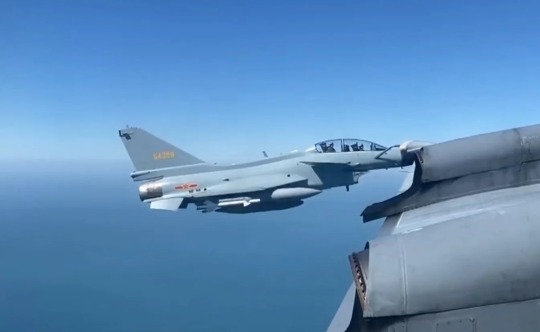
VIDEO: Chinese fighters perform "reckless" interception of Canadian military plane
Canadian Minister of Defense said that Chinese jet reached five meters from a Canadian surveillance plane in UN operation in international waters.
Fernando Valduga By Fernando Valduga 10/17/2023 - 22:38in Interceptions, Military
The Minister of Defense of Canada accused China of carrying out with his fighters a "dangerous and reckless" interception of a Canadian military plane in international waters.
Bill Blair said after Global News of Canada said that a Chinese J-10 jet reached five meters from a Canadian CP-140 Aurora maritime surveillance plane that was participating in a UN operation to impose sanctions against North Korea.
youtube
The incident occurred in international waters off the coast of China, said Global, which had a crew on the plane. Blair said that although the Chinese air force regularly interacts with planes on UN missions, Monday's incident put the Canadian aircraft at significant risk.

“I'm very worried about the unprofessional way this was done,” Blair said.
“It was frankly dangerous and reckless. And these types of behavior are never acceptable and we will express this to the People's Republic of China in the most appropriate way," he continued, but did not give details.
TAP RELOAD TO VIEW VIDEO PLEASE👇
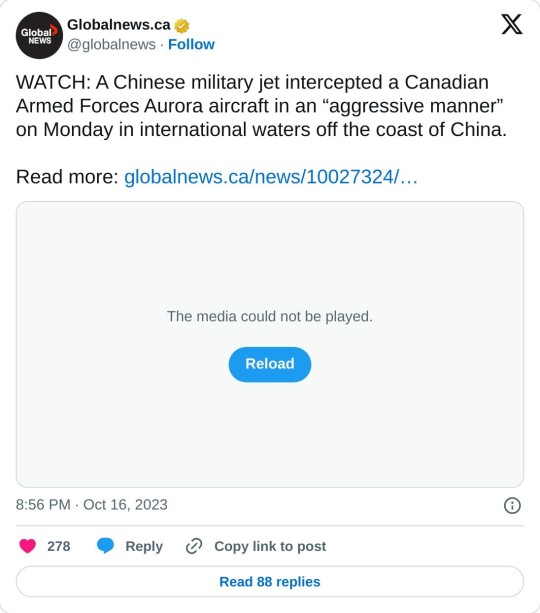
The Chinese embassy in Ottawa did not respond to a request for comment on the Global News report.
In June 2022, the Canadian military accused Chinese warplanes of harassing their patrol planes while monitoring sanctions evasions against North Korea, sometimes forcing Canadian planes to deviate from their flight routes.

In May, the Pentagon said that a Chinese fighter carried out an "unnecessarily aggressive" maneuver near a U.S. military plane over the South China Sea in international airspace. The meeting followed what Washington calls a recent trend of increasingly dangerous behavior on the part of Chinese military aircraft.
Tags: Military AviationInterceptionsPLAAF - China Air ForceRCAF - Royal Canadian Air Force/Canada Air Force
Sharing
tweet
Fernando Valduga
Fernando Valduga
Aviation photographer and pilot since 1992, has participated in several events and air operations, such as Cruzex, AirVenture, Dayton Airshow and FIDAE. He has work published in specialized aviation magazines in Brazil and abroad. Uses Canon equipment during his photographic work in the world of aviation.
Related news
BRAZILIAN AIR FORCE
FAB: Air traffic controllers assist crews in repatriation
17/10/2023 - 19:17
ARMAMENTS
ADEX: MBDA highlights Meteor air-to-air missile with the KF-21
17/10/2023 - 14:00
MILITARY
IMAGES: B-52 Stratofortress lands in South Korea for the first time
10/17/2023 - 08:35
EMBRAER
Czech Republic chooses the C-390 Millennium as its new military transport aircraft
10/17/2023 - 07:47
Moment when a U.S. Air Force strategic B-1B bomber lands on RAF Fairford, starting the Europe 24-1 Bomber Task Force. (Photo: Ryan Hayman / U.S. Air Force)
MILITARY
IMAGES: USAF returns with the B-1s to Europe
16/10/2023 - 22:08
The first Gripen E fighter of the Swedish Air Force equipped with new lithium-ion batteries takes off from Saab's main factory in Linköping. (Photo: Saab)
MILITARY
Saab switches to lithium-ion batteries in Gripen E
16/10/2023 - 20:56
6 notes
·
View notes
Text
Boeing Awarded $3.4 Billion Contract for 17 P-8A Poseidon Maritime Patrol Aircraft
aircraft for the Royal Canadian Air Force and three additional P-8s for the German Navy. In November 2023, Canada announced its decision to acquire the P-8A Poseidon to replace its current fleet of CP-140 Auroras. The first P-8A for Canada is expected to deliver in 2026. With the P-8 acquisition, Boeing’s economic commitments to Canada have the potential to generate annual benefits of more than 3,000 jobs for Canadian industry and value-chain partners, and at least $358 million to Canada’s gross domestic product over a 10-year period.
The U.S. Navy has awarded Boeing, a $3.4 billion contract to begin manufacturing 14 P-8A Poseidon maritime patrol
aircraft for the Royal Canadian Air Force and three additional P-8s for the German Navy. In November 2023, Canada announced its decision to acquire the P-8A Poseidon to replace its current fleet of CP-140 Auroras. The first P-8A for Canada is expected to deliver in 2026. With the P-8…
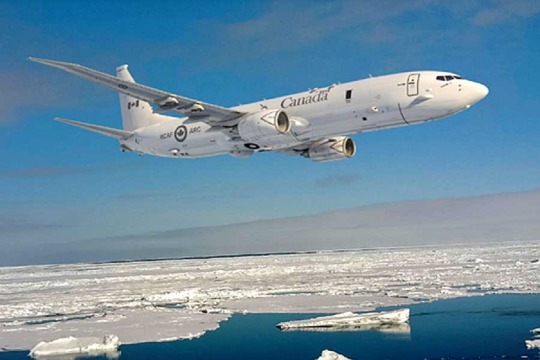
View On WordPress
0 notes
Text
Canadian ships dispatched to rescue storm-battered racing yachts
Canada has dispatched several ships and planes to assist in a daring ocean rescue of three racing yachts that are being hammered by a massive storm in the mid-Atlantic.
According to Major Rhonda Stevens, who is overseeing the operation through the Joint Rescue Coordination Centre in Halifax, two Canadian Coast Guard vessels, one naval ship and two Air Force planes have been dispatched to the scene, which is nearly 1,700 kilometres east of Newfoundland. Portugal has also sent a military aircraft.
“The weather on scene, and even en route, is extremely severe right now,” Stevens told CTV News Channel on Friday.
The sailboats had been competing in a transatlantic race hosted by England’s Royal Western Yacht Club that sees solo sailors and crews of two race from Plymouth, England to Newport, Rhode Island -- a distance of more than 2,900 nautical miles. The race began on May 29, but late Thursday, hurricane force winds of nearly 130 km/h and waves as high as 15 metres struck the flotilla. One boat lost its mast while two others sustained rigging or hull damage, Stevens said. Two of the disabled sailboats are being piloted single-handed while the third has a crew of two.
Canadian aircraft have already arrived at the scene in the mid-Atlantic, Stevens said, and they are maintaining communications with the three damaged vessels, which are spread over a roughly 380 kilometre radius. No severe injuries have been reported.
“They’re in good spirits,” Stevens said, “as good as they can be in the situation that they’re in with their vessels being damaged,”
A cargo ship and oil tanker, Steven added, may be able to reach the vessels as early as late Friday night. The Canadian Coast Guard and naval ships are expected to arrive by Saturday evening.
“We are extremely hopeful that within the next 12 to 24 hours we will be able to rescue those sailors,” Stevens said.
With files from The Canadian Press
#JRCCHalifax is responding to multiple sailing vessels in distress in the mid-Atlantic that were participating in trans-Atlantic races
— JTFA | FOIA (@JTFA_FOIA) June 9, 2017
HMCS CHARLOTTETOWN is proceeding to the area, as are 2 @CCG_GCC Ships (Pearkes and Cygnus) and 2 civilian tankers
— JTFA | FOIA (@JTFA_FOIA) June 9, 2017
#JRCCHalifax has tasked multiple #RCAF aviation assets to support including a CC-130 Hercules and a CP-140 Aurora from 14 Wing, Greenwood
— JTFA | FOIA (@JTFA_FOIA) June 9, 2017
from CTV News - Atlantic http://ift.tt/2r45ADJ
1 note
·
View note
Text
CANADA: Canadian Air Force plane deployed in search for missing Titan submersible
CANADA: Canadian Air Force plane deployed in search for missing Titan submersible
An aircraft from the Royal Canadian Air Force was deployed on Tuesday, June 20, to aid in the search of the missing 21-foot submersible vessel Titan that went missing during a dive to the Titanic’s wreckage on Sunday.
“The Royal Canadian Air Force CP-140 Aurora aircraft from Greenwood, NS will provide continuous on-scene support with additional aircrews and assets,” the Joint Rescue Coordination…

View On WordPress
0 notes
Text
Canadian aircraft lands in Japan ahead of mission to monitor North Korean smuggling - National
Canadian aircraft lands in Japan ahead of mission to monitor North Korean smuggling – National
A Royal Canadian Air Force patrol aircraft landed in Japan on Saturday ahead of its deployment to help monitor North Korean maritime smuggling activity.
The CP-140 Aurora, along with 40 Canadian personnel, will participate in a multi-national effort to monitor and counter North Korean smuggling activities designed to evade UN Security Council sanctions.
Foreign Affairs Minister Chrystia…
View On WordPress
0 notes

